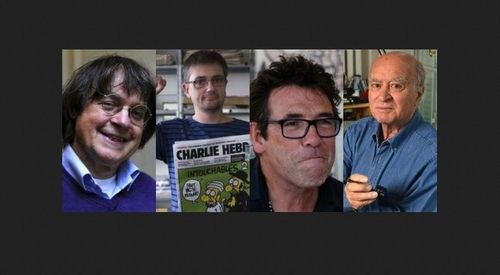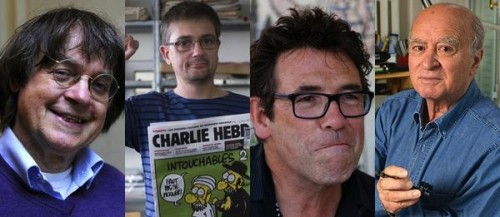
Denmark: Mark Steyn Analyzes the Mohammed Cartoon Crisis in Retrospect
10/01/2015
This year of 2015 has been a very bad one for free speech, starting with the Charlie Hebdo slaughter in January by jihadists, as Mark Steyn declared in his Copenhagen speech Saturday. In fact, Steyn observed that it has been “a disastrous 10 years” since the original Danish cartoon controversy that began when the newspaper Jyllands-Posten published 12 editorial cartoons of Mohammed that infuriated Muslims around the world.
On January 7, artists and staff of the satirical weekly Charlie Hebdo were slaughtered in their Paris office by jihadists. Left to right: Jean Cabut (“Cabu”), Stephane Charbonnier (“Charb”), Bernard Verlhac (“Tignous”), Georges Wolinski.

Steyn was one of the speakers at a Copenhagen meeting of the Danish Free Press Society considering the state of freedom over the last decade.
Steyn’s speech covered a lot of important territory in 49 minutes, including the disappearance of Seattle cartoonist Molly Norris into a witness-protection-style existence because she suggested Everyone Draw Mohammed Day. The idea created an event that put her on the Must Kill list of energetic jihadists. It was a moment in 2010 that demonstrated how much freedom America had lost because of Muslim immigration.
Steyn observed that in all the Paris demonstrations for free speech and against the murders of the Charlie Hebdo artists, no political figures held signs showing the offending art, even as they claimed to be one with the artists, as in “Je Suis Charlie Hebdo.” Everybody wanted to feel good about free speech, but self-censorship increased after the Paris jihad murders.
Few in print media displayed the images, although I found a few at the time and posted them, such as the one below from Berlin:

Steyn ended with a rousing call to live as free people in defiance of the jihad murderers: “Live as free people and don’t let the hate speech fairies and the Islamic enforcers — the good cop bad cop of totalitarianism — tell you you are not free.”
Wouldn’t ending Muslim immigration be the most effective strategy to preserve freedom? Muslim immigration has been entirely negative and threatens our entire civilization, yet many of the toughest critics won’t admit that stopping the infusion of poison is vital to saving the body politic.
Other than that important omission, I liked the speech.
Here’s a report about the meeting where Steyn spoke:
Denmark’s free speech conference kept the spirit of Charlie Hebdo alive, by Douglas Murray, Spectator, September 28, 2015This has been a terrible year for free speech. In January, after the atrocities in Paris, the whole world was ‘Charlie’, for about an hour. Then the violence and intimidation did the job they usually do (though we like to pretend otherwise) and by July even Charlie wasn’t Charlie anymore.
So I was delighted earlier this year when the Free Press Society of Denmark asked me if I would be willing to come to Copenhagen this September to take part in a conference to commemorate the 10th anniversary of the original ‘cartoon crisis’. I have spoken for this excellent group of doughty Danes before, and they have certainly shown more courage than the rest of the European media class combined. Not that they don’t pay a price for their bravery. The person who introduced me the last time I spoke for the organisation was the historian and journalist Lars Hedegaard. A while later a Muslim assassin arrived at his front door and tried to fire two shots at his head. Lars — who despite being in his 70s is as tough as anything — thankfully survived the attack.
Another founder member, who now heads the Lars Vilks Committee, is Helle Brix. It was her committee who organised the meeting on free speech in February this year that was shot up by an Islamist gunman (I interviewed her for The Spectator after that attack). In the meantime, there have been countless efforts to attack Jyllands-Posten, the newspaper which carried the original cartoons, and its editor, Flemming Rose, who commissioned the depictions. Interested readers can watch Flemming and me debating the peacefulness or otherwise of Islam, a few years ago in London here:
Anyhow — Saturday’s event was an important milestone and an important demonstration of force. As Mark Steyn — who was one of the other speakers at the conference — said, there aren’t many speakers still around from the 5th anniversary event. So it became even more important to ensure Saturday went well.
The conference was supported by the Danish Ministry of Culture and was hosted in the country’s parliament because this is the only building in Denmark which it is possible to protect from the now traditional arrival of the advance brigade of the Islamic blasphemy police. The Danish MP who opened the event took care to tell the audience that the parliament’s walls are very thick and strong. The presence of what seemed to me most of the Danish army seemed to help. Slightly more disconcertingly, Mark Steyn pointed out that on the day the British Foreign Office was recommending British tourists stay away from the environs of the Danish parliament because of fears that there would be a terrorist attack on our event. Needless to say the UK Foreign Office didn’t deign to pass this advice on to either Mark (a Commonwealth citizen) or me, but it’s good to know that they alerted British tourists to keep away from us. Personally I thought we both spoke rather well.
Anyway, it wouldn’t have made a difference, and it was a great thing to see the audience for Saturday’s event sold out many times over. Audience members I spoke to who defied the Foreign Office’s advice included Spectator readers from Yorkshire, London and Wales, and it was a great sight to see them join the huge contingents from Denmark, Norway and Sweden. I’ve never felt more proud of any readers. They gathered first to hear the great German journalist Henryk Broder, who got things off to a slightly gloomy start by predicting that the migration crisis spells the end of Europe. Then there was Vebjørn Selbekk, one of six Norwegian newspaper editors to publish the Danish cartoon in solidarity who told the less-well known story — and scandal — of the Norwegian cartoon crisis. I then tried to pick things up a bit by describing what we had learned, or not, over the last ten years. Mark Steyn rounded things off with a talk appositely titled ‘Last laughs’. I think we all left a bit more heartened, as well as informed, than when we went in.
I will post the videos of the occasion once they’re available. My main message for the audience was to keep in mind that freedom has never been particularly popular. Most people prefer their security and comforts to freedom and although history shows that everyone benefits from being free, it has always been a small minority who actually pursue and protect the cause. I suppose one has to wrestle whatever comfort one can from that. It was a terrible thing to see the security now needed in Denmark, as elsewhere, for people who are simply asserting their right to write and draw what they want, even — shock horror — things that might be mildly critical of the founder of one religion. That a journalist or historian should need bodyguards in 21st century Europe is an indictment on our continent. But still, surveying the room on Saturday I think we’ve got enough people. A few Danes, a few Swedes and Norwegians. A few Americans and a couple of Brits might be all that is needed. Perhaps by the 15th anniversary things will be better.
Or perhaps not. One of the stand-out points of the day came from an audience member who was worried about the flow of Muslim migrants into Denmark. Whichever way you look at it, he pointed out, and however many thousands of migrants Denmark takes in, these will be thousands more people who do not believe Danes have a right to write, draw and publish what they want. Still, as I’ve pointed out elsewhere, import a new generation with Islamic ideas into an old continent with Christian secular ideas, and what could possibly go wrong?
